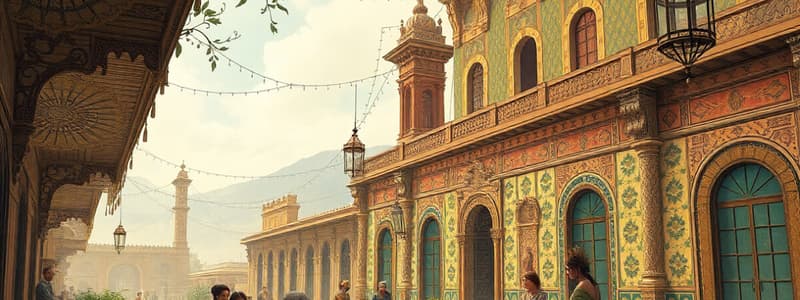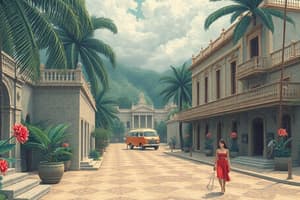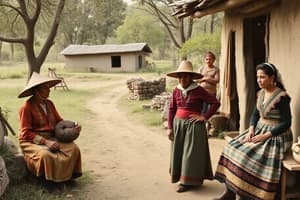Podcast
Questions and Answers
What was the primary source of insight into the lives of citizens in the United States and Mexico during the first half of the nineteenth century?
What was the primary source of insight into the lives of citizens in the United States and Mexico during the first half of the nineteenth century?
- Government records
- Materials from foreign travelers (correct)
- Accounts of local inhabitants
- Historians' interpretations
What significant impact did the Mexican wars for independence have on the population?
What significant impact did the Mexican wars for independence have on the population?
- A radical improvement in social structures
- An increase in the birth rate
- A rise in immigration to the country
- A high number of casualties and permanent family separations (correct)
How did the rate of population growth in Mexico change after 1810?
How did the rate of population growth in Mexico change after 1810?
- It continued to grow rapidly
- It leveled off dramatically (correct)
- It began to decline immediately
- It increased dramatically
Which of the following was NOT a consequence of the Mexican wars for independence?
Which of the following was NOT a consequence of the Mexican wars for independence?
What observation was made by visitors to Veracruz several years after the wars ended?
What observation was made by visitors to Veracruz several years after the wars ended?
What change occurred at the top of the social structure during the late colonial period?
What change occurred at the top of the social structure during the late colonial period?
How did the population of Mexico change from 1800 to 1850?
How did the population of Mexico change from 1800 to 1850?
What aspect of social thinking remained static despite the republican government's changes?
What aspect of social thinking remained static despite the republican government's changes?
What was the primary form of dwelling among the pueblos in southern and central Mexico?
What was the primary form of dwelling among the pueblos in southern and central Mexico?
What was a common element shared with families in the Indian dwellings?
What was a common element shared with families in the Indian dwellings?
What material was more commonly used for building in the northern regions of Mexico?
What material was more commonly used for building in the northern regions of Mexico?
Which statement about the pueblos is true?
Which statement about the pueblos is true?
What element did Carl Sanorius note about the Indian dwellings in 1850?
What element did Carl Sanorius note about the Indian dwellings in 1850?
What invalid assumption could be made about the social class changes after the disappearance of gachupines?
What invalid assumption could be made about the social class changes after the disappearance of gachupines?
How did the classification of Indians change under the republican government?
How did the classification of Indians change under the republican government?
Flashcards
Casualties of war
Casualties of war
The loss of life in war, especially the number of people killed.
Dislocations caused by war
Dislocations caused by war
The movement or displacement of people from their homes, often due to war or disaster.
Orphans
Orphans
The state of being abandoned or without a parent or guardian, often caused by war or tragedy.
Leveling off of population growth
Leveling off of population growth
Signup and view all the flashcards
Slow changes in social structure
Slow changes in social structure
Signup and view all the flashcards
Social Stability in Mexico
Social Stability in Mexico
Signup and view all the flashcards
Who Were the Gachupines?
Who Were the Gachupines?
Signup and view all the flashcards
Mexican Citizenship and Indigenous Identity
Mexican Citizenship and Indigenous Identity
Signup and view all the flashcards
Criollos' Rise to Power
Criollos' Rise to Power
Signup and view all the flashcards
Who Were the Aiollos?
Who Were the Aiollos?
Signup and view all the flashcards
Indigenous Population in 19th Century Mexico
Indigenous Population in 19th Century Mexico
Signup and view all the flashcards
Types of Housing in Indigenous Villages
Types of Housing in Indigenous Villages
Signup and view all the flashcards
Pueblos: Traditional Communities
Pueblos: Traditional Communities
Signup and view all the flashcards
Carl Sartorius' Observations
Carl Sartorius' Observations
Signup and view all the flashcards
Metate & Mano - Tools for Grinding
Metate & Mano - Tools for Grinding
Signup and view all the flashcards
Study Notes
Society and Culture in the First Half of the 19th Century
- Historians often rely on foreign accounts of local life, as descriptions common to locals can be viewed as unique by outsiders
- Mexican War of Independence, though smaller than other conflicts, resulted in significant casualties (estimated at half a million deaths, roughly 1/12th the population)
- Disruption & displacement caused by war delayed recovery
- Population growth slowed dramatically following the war
- Social structures remained largely unchanged
- "Gachupines" disappeared from top, the "Criollos" took their place.
- Despite republican government, racial classifications persisted.
Population
- Mexico was a primarily rural society in the first half of the 19th century
- Indigenous peoples inhabited small villages, living in uniform dwellings, adapting to regional climates
- Homes varied in construction (adobe in north, reeds and thatch in south) but commonly shared living quarters with livestock
Rural Towns
- Towns, generally larger than villages, were usually mestizo, or mixed-race population, influenced by Mexican ways of life.
- Markets and community gatherings (weekly/bi-weekly) were common, attracting people from surrounding areas.
- Infrastructure was limited and life rustic;
- Schools and educational facilities were few; medical care was limited to local healers
- The daily struggle and challenges were palpable
Mexico City
- Mexico City served as a hub, attracting the rich and poor, with a large population
- Wide, paved streets contrasted starkly with the poverty and deprivation in other parts of the city
- Contrast between wealth and poverty in Mexico City evident
- Large population, wealthy and poor residents
- Infrastructure and amenities, though limited in the wider country, were present in provincial cities.
Intellectuals and Artists
- Romanticism was the prevailing literary style; focusing on individual expression and national identify
- Artistic and literary trends emphasized indigenous culture, history, and independence
- Academic institutions and artists were seeking to produce distinctly Mexican forms of expression.
Cargadores
- Cargadores were laborers, carrying loads on their backs.
- Their work was vital to the economy
- The hardships faced by the cargadores contrasted with the more privileged classes
- Labourers played a considerable part in the well-being of the society
Studying That Suits You
Use AI to generate personalized quizzes and flashcards to suit your learning preferences.
Related Documents
Description
Explore the social structures and cultural changes in Mexico during the first half of the 19th century. This quiz delves into the impact of the Mexican War of Independence, population growth, and the living conditions of indigenous peoples. Test your understanding of this pivotal period in history.




